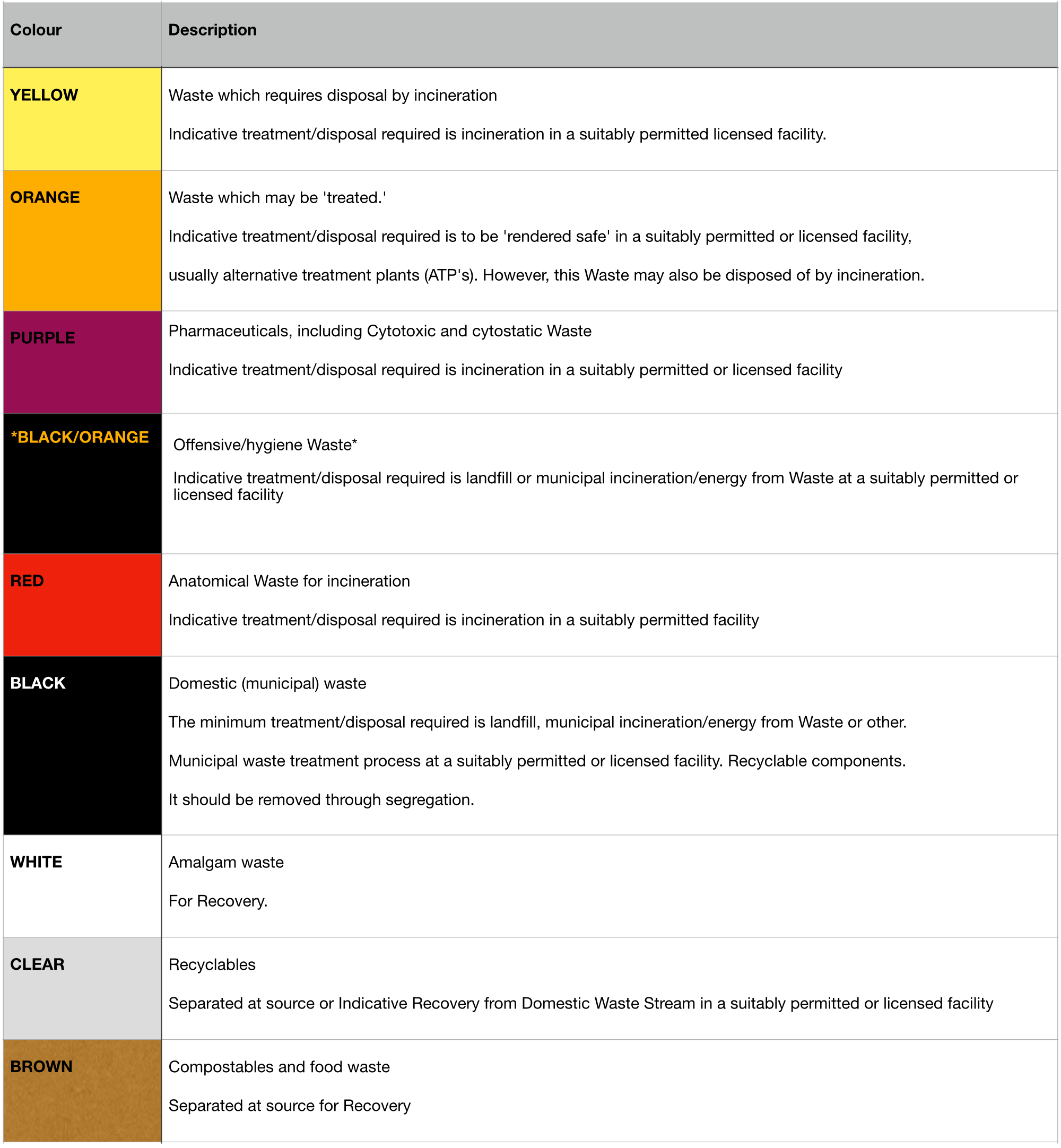Waste
Management of Healthcare Waste
Clinical Waste means Waste from a healthcare activity (including veterinary healthcare) that :.
- contains viable microorganisms or their toxins known or reliably believed to cause disease in humans or other living organisms.
- contains or is contaminated with a medicine that contains a biologically active pharmaceutical agent, or
- is a sharp or body fluid or other biological material (including human and animal tissue) containing or contaminated with a dangerous substance within the meaning of Regulation (EC) No 1272/2008 of the European Parliament and of the Council on Classification, labelling and packaging of substances and mixtures, as amended from time to time.
Offensive Waste is not clinical Waste. However, it contains body fluids, secretions or excretions and falls within the description of the list of wastes established by Commission Decision 2000/532/EC.
Health Technical Memorandum (HTM) 07-01 provides a framework for best practice waste management across the UK to help healthcare organisations and other healthcare waste producers meet legislative, technical and policy requirements and plan for future challenges and opportunities. HTM 07-01 Safe and Sustainable Management of Healthcare Waste has been produced to replace the 2013 version of Safe Management of Healthcare Waste. The guidance in HTM 07-01 is intended to reflect better the key principles in sustainable healthcare waste management, specifically that of the circular economy, environmental protection, improved social outcomes, and reduced carbon emissions.
Safe Disposal of Waste
- Always dispose of Waste immediately and as close to the point of use as possible.
- Segregated waste into the correct colour-coded UN 3291 approved waste bag or container (rigid container or sharps box if sharp).
- Liquid Waste, e.g. blood, must be rendered safe by adding a polymer gel (Refer to Safety Alert) or compound before placing it in an orange-lidded leakproof bin.
- Do not fill waste bags must be no more than 3/4 full and no more than the UN-approved weight, and use a ratchet tag/or tape (for healthcare waste bags only) using a ‘swan neck’ to close.
- Always store all Waste in a designated, safe, lockable area while awaiting uplift.
- Uplift schedules must be acceptable to the care area, and there should be no build-up of waste receptacles.
- Local guidance on managing Waste at the care level, e.g. domiciliary settings, should be followed.
Although the HTM 07-01 is relevant to all four UK countries, some countries have adopted the guidance to suit their devolved health systems. Therefore, differences exist concerning some practices and the colour coding of waste containers.
- All healthcare organisations should have a waste policy that specifies how it manages Waste and identifies who is responsible for it.
- The safe management of healthcare waste is the responsibility of all healthcare professionals, and they must understand how Waste should be classified, segregated and stored before collection or disposal.
- Segregation of Waste is essential for compliance with waste regulations. Appropriate colour coding of waste containers should be used to ensure effective segregation. The tables below outline the colour coding of waste receptacles for Northern Ireland:
Sharps containers
- Sharps containers must have a handle (small community boxes do not require a handle) and a temporary closure mechanism employed when the box is not in use.
- They should be disposed of when the manufacturer’s fill line is reached.
- They must be labelled with the point of origin and date of assembly and disposal.
- Where reusable sharps containers are used, organisations must have protocols to ensure their safe use and reprocessing.

Notes
- The use of Black/Orange for offensive/hygiene waste was chosen as these colours denote that the Waste is non-infectious but contains materials that derive from a healthcare setting that needs to be treated differently from standard Domestic Waste.
- The colour ‘red’ is new to the colour coding system in this edition. Care should be taken when ordering red containers to ensure that they can be clearly differentiated from orange. The colour coding could be agreed upon as part of a contract.
- Cytotoxic and Cytostatic Wastes have a recognised label on the rigid container to differentiate them from other pharmaceutical waste products. This label should be available to all departments that produce Cytotoxic/Cytostatic Waste.
- The colour ‘brown’ denotes compostable or food waste. The receptacles or sacks should be biodegradable as agreed as part of a contract specification.
Sharps
Sharps in the healthcare setting include hypodermic syringe needles, suture needles and scalpels. All sharps should be disposed of in a suitable container:

Most healthcare organisations/facilities use purple-lidded sharps receptacles for cytotoxic/cytostatic sharps and yellow or orange-lidded sharps receptacles for all other sharps.
Literature review:
- Safe disposal of Waste.
- https://www.nipcm.hps.scot.nhs.uk/resources/evidence-and-research/
